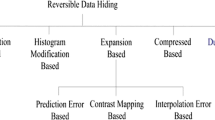Abstract
Reversible data hiding methods can embed secret data into multimedia to prevent attacks from hackers. Reversible data hiding methods based on multiple stego-images have been proposed extensively in recent years. This type of method can embed large amounts of secret bits into several stego-images. However, data embedding may cause serious distortion of stego-images. To solve this problem, Lu et al. proposed a center-folding strategy to reduce secret digits to narrow down the distance between the original pixel and the stego pixel in 2015. Although the center-folding strategy works well, it can still be improved. In their proposed scheme, the maximum secret digit seriously damages the image quality of the stego-image. If the maximum secret digit occurs often, then the visual quality of the stego-image decreases quickly. In this paper, we propose a frequency-based encoding method to solve this problem. The secret digit that occurs most frequently is encoded as the minimum absolute digit, thereby decreasing the frequency and level of modification. Experimental results showed that the proposed method can achieve a greater peak signal-to-noise ratio value than previous methods, thereby confirming that the proposed method is effective.

















Similar content being viewed by others
References
Chang CC, Kieu TD, Chou YC (2007) Reversible data hiding scheme using two steganographic images, in Proceedings of IEEE Region 10 International Conference (TENCON), pp. 1–4
Chang CC, Chou YC, Kieu TD (2009) Information hiding in dual images with reversibility, in Proceedings of the Third International Conference on Multimedia and Ubiquitous Engineering, pp. 145–152
Chang CC, Lu TC, Horng G, Huang YH, Hsu YM (2014) A high payload data embedding scheme using dual stego-images with reversibility, Proceedings of third international conference on information, communications and signal processing, 1–5
Gui X, Li X, Yang B (2014) A high capacity reversible data hiding scheme based on generalized prediction-error expansion and adaptive embedding. Signal Process 98:370–380
Lee CF, Huang YL (2013) Reversible data hiding scheme based on dual stegano-images using orientation combinations. Telecommunication Systems 52(4):2237–2247
Lee CF, Wang KH, Chang CC, Huang YL (2009a) A reversible data hiding scheme based on dual steganographic images, Proceedings of the third international conference on ubiquitous information management and communication, 228–237
Lee CF, Wang KH, Chang CC, Huang YL (2009b) A reversible data hiding scheme based on dual steganographic images, Proceedings of the 3rd international conference on ubiquitous information management and communication, pp. 228–237
Lu TC, Lu CM, Chang CC (2007) Multimedia Security Techniques, Taiwan: CHWA
Lu TC, Tseng CY, Wu JH (2015a) Dual imaging-based reversible hiding technique using LSB matching. Signal Process 108:77–89
Lu TC, Wu JH, Huang CC (2015b) Dual-image-based reversible data hiding method using center folding strategy. Signal Process 15:195–213
Ni Z, Shi YQ, Ansari N, Su W (2006) Reversible data hiding. IEEE Transactions on Circuits and Systems for Video Technology 16(3):354–362
Qin C, Chang CC, Hsu TJ (2014) Reversible data hiding scheme based on exploiting modification direction with two steganographic images. Multimed Tools Appl 74(15):5861–5872
Thodi DM, Rodriguez JJ (2004) Prediction-error based reversible watermarking. Proc IEEE Conf Image Process 3:1549–1552
Thodi DM, Rodriguez JJ (2007) Expansion embedding techniques for reversible watermarking. IEEE Trans Image Process 16(3):721–730
Tian J (2003) Reversible data embedding using a difference expansion. IEEE Trans Circuits Syst Video Technol 13(8):890–896
Wang SY, Li CY, Kuo WC (2013) Reversible data hiding based on two-dimensional prediction errors. IET Image Process 7:805–816
Zhang X, Wang S (2006) Efficient steganographic embedding by exploiting modification direction. IEEE Commun Lett 10(11):781–783
Acknowledgments
The authors would like to thank Mr. Ying-Hsuan Huang who give us great advice and technical support and the Ministry of Science and Technology of the Republicof China, Taiwan, for financially supporting this paper under Contract no MOST 105-2221-E-324 -020.
Author information
Authors and Affiliations
Corresponding author
Rights and permissions
About this article
Cite this article
Lu, TC., Chi, LP., Wu, CH. et al. Reversible data hiding in dual stego-images using frequency-based encoding strategy. Multimed Tools Appl 76, 23903–23929 (2017). https://doi.org/10.1007/s11042-016-4135-2
Received:
Revised:
Accepted:
Published:
Issue Date:
DOI: https://doi.org/10.1007/s11042-016-4135-2




